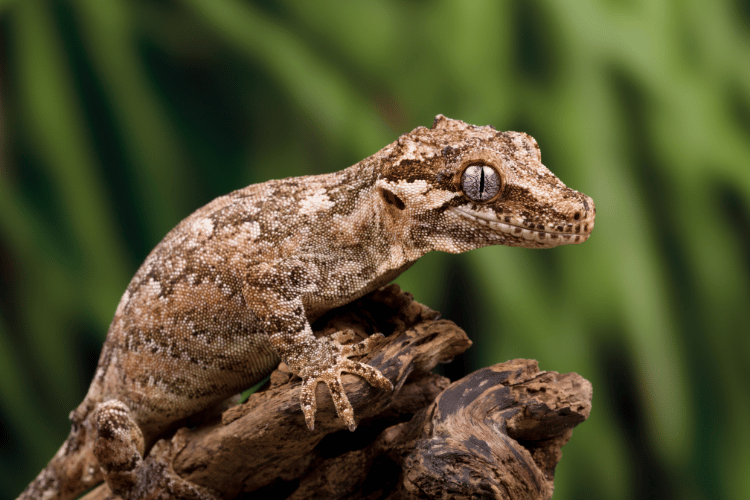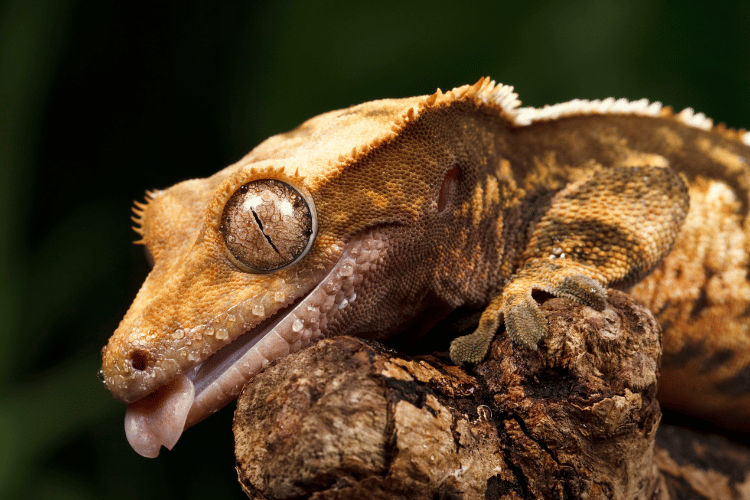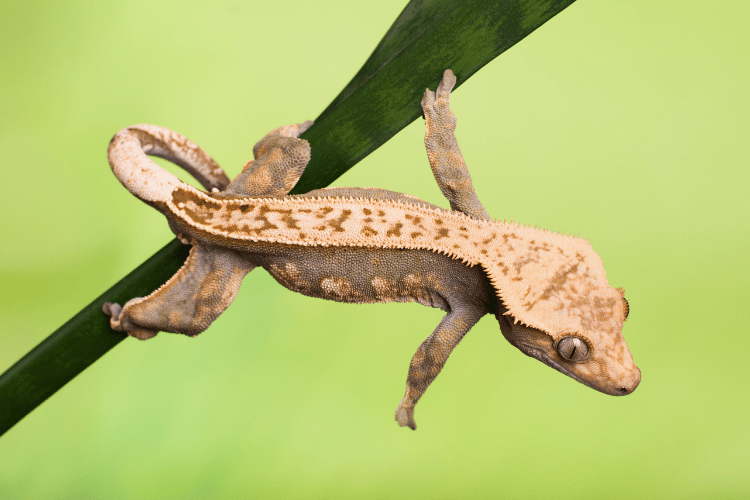Geckos are friendly, docile creatures that are easy to care for. That’s why people from all over the globe adopt these reptiles as pets.
There are quite a few different species of geckos. Each one has unique features and characteristics.
Although, many of them look similar. Because of that, it can be a little tricky to tell the species apart.
So, if you’re comparing crested geckos vs. gargoyle geckos, you’ve come to the right place. In this article, we’ll go over the key differences and similarities between the two reptiles.
We’ll also cover which one of them would make a better pet.

Crested Gecko Overview
Crested geckos are part of the Diplodactylidae family, and native to New Caledonia. The first record of these reptiles dates back to 1866.
Yet, for a short while, most people believed that they went extinct. This was until 1994 when Robert Seipp led an expedition to New Caledonia.
Today, it’s one of the most popular gecko species in the world.
They get their names from the soft spikes that grow on their heads and eyes. However, some people also refer to the reptiles as eyelash geckos.
That’s because of their Latin name ciliates. Cilia is another word for thin hairs or eyelashes.
Moving on, crested geckos have a friendly demeanor and a playful nature. That’s what makes them amazing pets.
Other than that, the reptiles are low maintenance with a simple diet. All you have to do is monitor the temperature range and humidity of their enclosure.
Plus, they don’t make a huge mess. For the most part, they stick to their space and they keep it tidy.
Yet, crested geckos aren’t as energetic as other pets like dogs. The reptiles are quiet and keep to themselves for most of their lives.
Gargoyle Gecko Overview
Gargoyle geckos are another species that are popular pets. That’s because they have a laid-back temperament and they don’t have a problem with strangers.
These reptiles get their common name from their Latin title, Rhacodactylus auriculatus. The word auriculatus loosely translates to ear or eared.
This refers to the horn-like structures that grow on the head of gargoyle geckos. That’s also why some people call this animal the bumpy gecko.
Besides that, just like the crested variety, it’s a Caledonian gecko species. They prefer to live in a warm, humid environment.
Yet, they can be a little picky about what they eat. Other than that, they don’t need much space to thrive.
While gargoyles are usually friendly geckos, they can get a bit territorial. For that reason, it’s best to house them on their own, away from other geckos.
These reptiles are solitary creatures that are happy with a small enclosure. As long as you keep the cage clean and you remember to feed the little critters, taking care of them should be a breeze.
Finally, gargoyle geckos have prehensile tails. That means the limb can regrow if it’s damaged or detached.
Crested Gecko vs. Gargoyle Gecko
At this point, you have a little background information on each reptile species. So, we can begin to compare the two geckos.
In this section, we’ll look at the major differences in their characteristics.
1. Appearance
Crested geckos and gargoyle geckos belong to the same reptile family. Because of that, they have quite a few physical characteristics in common.
For starters, both have webbed feet and sharp claws. However, gargoyles tend to have more extended talons.
This helps the reptiles climb on rough surfaces.
Plus, the two species don’t have eyelids. Instead, they use their tongues to keep their eyes clean and hydrated.
That’s why you’ll see the geckos periodically lick their eyes.
Moving on, when it comes to crested geckos, they have a distinct feature. When you examine them, you’ll notice little spines covering their bodies from head to tail.
On the other hand, gargoyle geckos only have a few bumps on their heads.
2. Size
If you place a gargoyle gecko next to a crested gecko, you’ll notice a slight difference in size.
On average, a fully grown crested gecko grows to about eight to nine inches long, from head to tail.
In contrast, some gargoyle geckos can reach about 10 inches from snout to tail. This means that the latter is a bit larger.
Although, you may not be able to see the difference with the naked eye. However, the same isn’t true for the weight of these reptiles.
Typically, adult crested geckos weigh around 1.94 oz (55 grams). This is on the smaller side for geckos.

As for adult gargoyle geckos, they can weigh as much as 2.82 oz. (80 grams). So, the latter is the heavier gecko.
3. Gecko Diet and Nutrition
When it comes to diet, crested geckos tend to be easy to please. These reptiles eat all sorts of fruit like mangos, bananas, and even blueberries.
Other than that, the geckos need live insects to survive. Small critters like grasshoppers, spiders, and crickets should do the trick.
Not only do these provide nutrients, but they help your pet develop its hunting abilities. To top it all off, you only need to feed an adult crested gecko three times a week.
Moving on, gargoyle geckos are more picky when it comes to food. Even though they’re also omnivores, some of these reptiles aren’t huge fans of live insects.
They only eat a select few critters like waxworms, crickets, and dubia roaches.
Besides that, the rest of their varied diet consists of fruits and vegetables. Unlike the crested variety, gargoyle geckos can survive on one meal a week.
Finally, both species can thrive on commercially prepared gecko food. Although, you’ll need to feed them live insects too, so that they can develop normally.
4. Enclosures
Crested and gargoyle geckos are relatively small pets. Because of that, neither reptile needs a particularly large enclosure.
On average, you’ll need a terrarium that’s about 10 gallons in volume for both species.
This should provide them with enough room to move around and stay healthy. Plus, you have to remember that geckos are arboreal, which means they enjoy climbing.
So, it’s best to buy a tall enclosure, as opposed to a wide one.
Aside from that, both crested and gargoyle geckos like to hide when it’s time to sleep or eat. For that reason, you have to provide them with plenty of objects that they can use for camouflage.
That’s why there should be many rocks and foliage inside the enclosure.
5. Environmental Care Requirements
Both crested and gargoyle geckos prefer to live in warm, humid environments. Although, the latter is a bit more choosy.
Generally, a crested gecko will thrive in a temperature between 72℉ and 75℉. Plus, they need a humidity of around 60% to stay healthy.
That’s why you’ll need UVB lighting to warm up the space.
Yet, for gargoyle geckos, you’ll need to turn the heat up. They prefer their enclosure to stay at a toasty 78℉.
On top of that, the humidity in the terrarium should be around 70% to 80%.
6. Period of Activity
The majority of gecko species are nocturnal. That means that they’re only active during the night.
Although, that’s not the case for all of these pet reptiles. For instance, crested geckos are crepuscular.
This indicates that they’re at their most active during the twilight periods. These include dusk and dawn.
As for gargoyle geckos, they’re only active after dark.
7. Behavior
For the most part, both crested and gargoyle geckos have friendly personalities. They have no problem interacting with humans and they tend to be docile.
Although, crested geckos are a bit more skittish. They can be a little shy when you first adopt them, but they’ll warm up to you quickly.
Moving on, gargoyle geckos don’t like to share their space. This is especially true for the males of the species.
If you place them in an enclosure with another gargoyle gecko, they’ll fight over territory. That’s why it’s best to adopt these critters on their own.
8. Colors
Crested geckos come in a variety of colors. These include yellow, orange, cream, pink, olive, tan, brown, and red, to name a few.
Plus, they come with several patterns on their backs.
Besides that, gargoyle geckos also have a few morphs. They come in a wide array of colors like white, yellow, brown, orange, and red.
In addition, they have distinct markings that run from head to tail.
9. Lifespan
Crested geckos have a life expectancy that’s longer than most average pets. With the proper care and diet, these reptiles can live up to 20 years.
That means they’ll outlive most dogs and cats.
Sadly, gargoyles aren’t as lucky. Under the perfect conditions, these critters can survive for about 15 years.
10. Mating Habits
Crested and gargoyle geckos have similar mating habits. For starters, they can both get a little aggressive.
It’s not uncommon for males to bite females on the neck and tail before they copulate. Other than that, they both vocalize quite a bit during mating.
Moving on, the two reptiles lay eggs with a similar frequency.
Crested geckos can lay a clutch of two eggs every 30 days. As for gargoyles, they’ll lay two soft-shelled eggs every 28 days.
11. Handling
Reptiles aren’t typically the most affectionate creatures. Although, you can cuddle with geckos every so often.

When it comes to handling, crested geckos can be a little shy. They’ll avoid touch for the first few weeks of adoption.
Yet, once they get used to their new environment, they should be easy to pick up.
Moving on, gargoyles are simpler to handle. It’ll only take them a few hours to adjust to their new environment.
However, some gargoyle geckos can be temperamental.
12. Brumation
Brumation is the reptile version of hibernation. When the temperature in the enclosure drops below 60℉, the geckos will go to sleep.
This is in an effort to protect their bodies from any damage. That can happen in both crested geckos and gargoyle geckos.
Although, this shouldn’t be much of an issue in captivity. As long as you keep the terrarium setup warm, the reptiles should stay active all year round.
13. Prehensile Limbs
As we mentioned, gargoyle geckos have prehensile tails. This allows them to replace the crucial limb that they use for climbing and moving.
Yet, crested geckos aren’t as lucky. They have semi-prehensile tails.
That means they can drop the structure if it’s damaged. However, they won’t be able to regrow it later on.
This would be a major disadvantage in the wild, but in captivity, it’s not a huge issue.
14. Cost
Both crested and gargoyle geckos come at a wide range of price points. Depending on their color and markings, the cost of these reptiles can vary greatly.
Although, gargoyles tend to be a little more expensive. In fact, some morphs can run you a few hundred dollars.
15. Availability
Most reptile dealers will have a selection of both species. Although, some gargoyle gecko morphs are a bit tricky to come by.
They’re a little rare and it may take a few months to track them down.
Crested Gecko vs. Gargoyle Gecko: Which Makes the Better Pet?
If you’re new to the reptile world and look for your first gecko, then a crested gecko is the way to go.
That’s because these animals are gentle and easy to care for. On top of that, maintaining the environment of their enclosures should be a cakewalk.
So, they’re an excellent choice for beginner pet owners.
However, if you have some experience with geckos, then a gargoyle may be best. These reptiles are a little picky when it comes to food, but they’re fun-loving.
Other than that, it may be tricky to ensure that their terrarium is warm and humid enough.
Wrapping Up
If you’re comparing crested geckos vs. gargoyle geckos, we can help you out. When it comes to appearance, crested geckos have spikes all over their bodies.
As for gargoyles, they have horns on their heads.
Moving on, crested geckos come in a few more shades. Plus, some gargoyle morphs are difficult to find.
Other than that, both of the species tend to be docile. Although, gargoyles can get a little territorial with other geckos.
- Can Leopard Geckos Eat Silkworms? - March 11, 2024
- Do Leopard Geckos Climb? - March 4, 2024
- Do Leopard Geckos Bask? The Answer Will Surprise You - February 21, 2024
